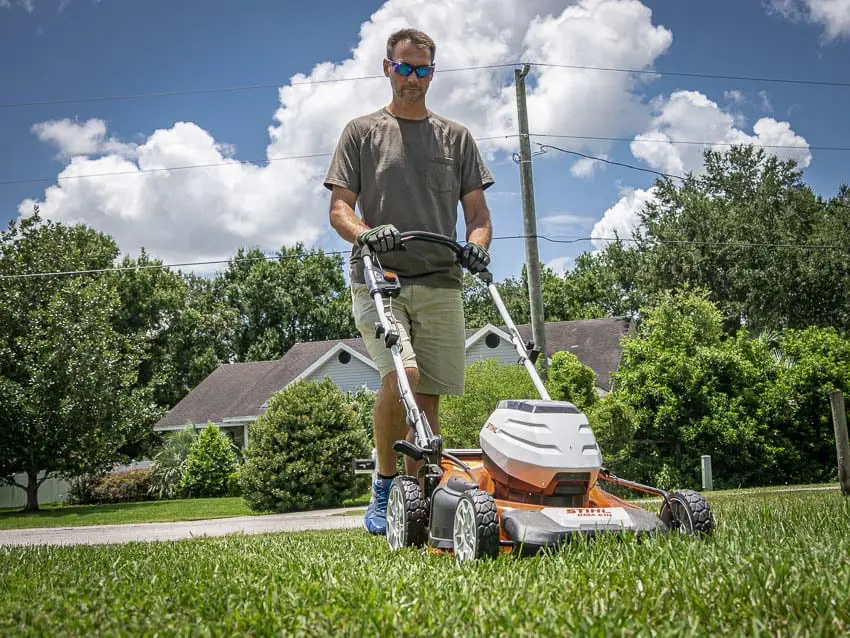The Stihl RMA 510 Shows Its Class in Our Push Mower Head-to-Head
While Stihl also has the RMA 510 V self-propelled battery-powered lawn mower, our best electric lawn mowers article featured the user-propelled version, the Stihl RMA 510. Not only is the RMA 510 reasonably lightweight, but it also has the kind of feature set, cutting speed, and quiet operation that earns it a 2nd place finish in our battery-powered push mower testing.
Pros
- Folds for easy vertical storage
- Nimble feeling when mowing
- Solid runtime (48 minutes on a maintenance cut)
- Has the most power in heavy-duty cutting for a push mower
- Steel deck with single-point cutting height adjustment and 6 cutting heights (ranging from 1-1/2″ to 4″)
- Additional battery storage bay
Cons
- Pricey as a kit
Cutting Performance
Cutting Power
While the Stihl RMA 510 battery-powered mower does a lot of things right, it doesn’t do anything nearly as right as it does cutting speed and power. In fact, the more load we applied to the RMA 510, the better it performed.
Starting with its no-load speed, the 20″ blade moved at 2820 RPM and clocked 167.7 MPH blade tip speed. This was the second-fastest cordless push mower we tested at this point.
Moving into maintenance load testing, the Stihl battery-powered mower basically maintained its blade tip speed, logging in a slight increase at 2822 RPM and 167.8 MPH. At this point, again, it’s still finishing in second for its group. When you’re talking about a weekly cut, this kind of speed is more than enough to do the job well.
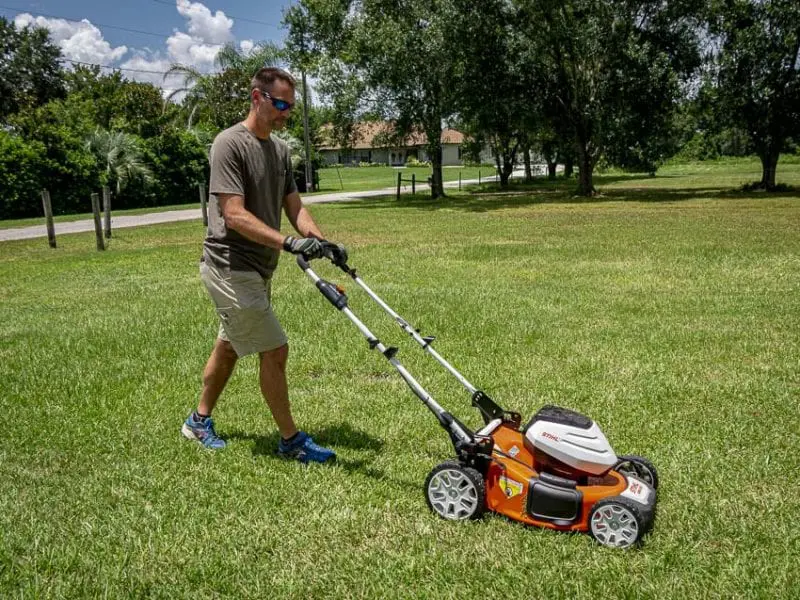
However, when we moved into heavy load testing, we noticed that the RMA 510 really kicked things up a notch. With a tip speed change of 23.8 mph, the Stihl battery model topped out at 3223 RPM and 191.7 mph. This speed was enough to top our group for heavy load testing, showing that when the going gets tough, the Stihl will only improve its performance.
Torture Test
Because we were so impressed with the Stihl’s cutting power and speed, we thought we’d try to beat it up a bit by including it in our torture test. We set it in 5 weeks worth of grass growth at a cutting height of 2.5″, and we pushed it at a constant 2.5 MPH until the blade stopped.

It performed pretty well, matching the Makita push mower model at 30.5′. We did test several other battery-powered models that managed to cut more than either of these, though we saw mowers that cut a whole lot less as well.
The takeaway from this subjective-type test (we didn’t include it in our scoring because of the inconsistency and variables of the test) is that the Stihl RMA 510 can handle a few days worth of overgrowth reasonably well, though letting your lawn go for more than a few extra days might mean that you’ll need to cut slowly or in half swaths.
Cutting Area
With the RMA 510, Stihl has opted for a 20″ blade. This falls about square in the middle of the range of deck mower sizes we’re seeing on cordless lawn mowers. The Makita LXT 18V X2 mower has an 18″ blade, while the Greenworks Commercial model tops the charts with twin blades that cover 23-3/4″. While those are the extremes, most cordless mowers are in the 19″ – 21″ range.
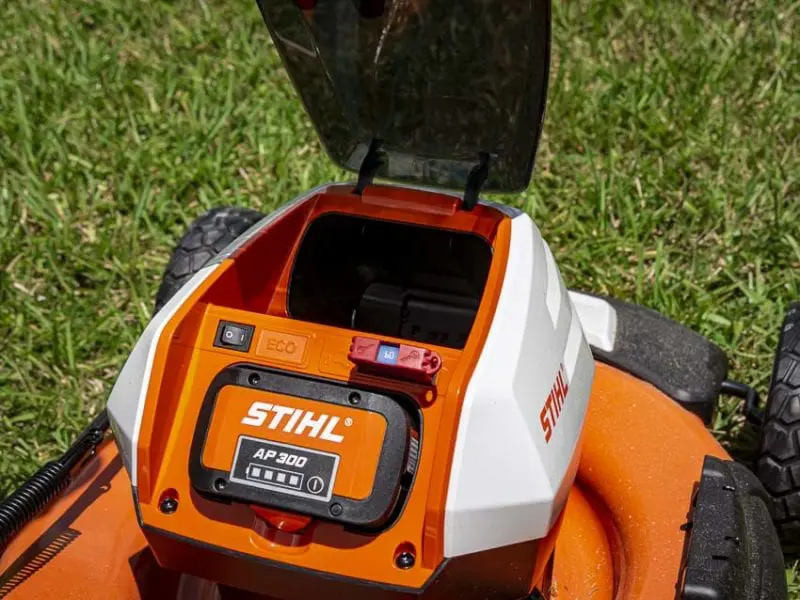
Stihl’s mower runs on a 36V AP 300 battery, which has been redesigned to provide full power until the battery runs dead… and takes 48 minutes to do with your typical maintenance cut. Incidentally, this wound up as the third-best time we saw from the battery-powered push mowers. It finished about 9 minutes less than the Worx 40V model, and 3 minutes behind the Makita.
But what does that look like in practical terms? On one charge, you can expect to mow 17,600 square feet if you maintain a consistent 2.5 mph walking speed. This breaks down to 2/5 of an acre on a charge. Just keep in mind that’s an ideal scenario and we all lose 5% – 10% as we overlap cutting lines.
That AP300 battery gives you enough runtime to handle a lot size up to 1/3-acre. If you have a larger lawn, a second battery should help you cover more than a 1/2-acre easily.
When it comes to charging, the AP300 battery goes from dead to full in just under an hour.
Noise Level
One of the big selling points with battery-powered OPE revolves around the noise they put out; cordless isn’t nearly as loud as gas. The Stihl RMA 510 pumped out 80 dB(A), which sat about mid-table for the battery models. Considering the quietest gas mower we tested – the Honda Commercial HRC216HXA – rang out at a relatively quiet 86 dB(A), your ears will thank you for switching to cordless.
Feature Set
Ultimately, we prefer self-propelled models when it comes to walk-behind mowers. Unfortunately, the Stihl battery-powered mower only comes in one flavor presently, a push mower. Look for this to change soon, as the brand plans on releasing a self-propelled model.
Steel Deck
The Stihl RMA 510 features a steel deck, rather than the plastic ones we’re seeing more and more of. While plastic can cut down on the overall weight, and benefit push mowers particularly, a steel deck will stand up to more wear from things like sugar sand. Ultimately, a steel deck is just more durable.
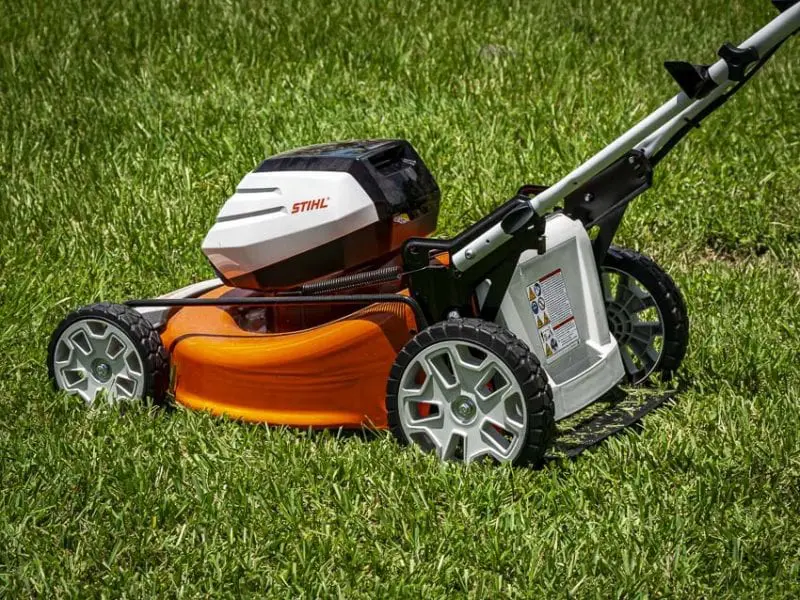
Height Adjustment and Range
We also appreciate the single-point height adjustment on the RMA 510. Rather than futzing around with height adjustments on multiple wheels, one single setting adjusts your cutting height in any one of 6 positions ranging from 1.5″ – 4″ (Stihl specs indicate a max cutting height of 3-3/4″, but we measured a quarter-inch more).

Handle Positions
The handle on the Stihl RMA 510 can adjust to any of three positions as well, making the mowing experience comfortable for most operator heights. When the job is done, the handle can fold over for the mower to be stored away vertically.
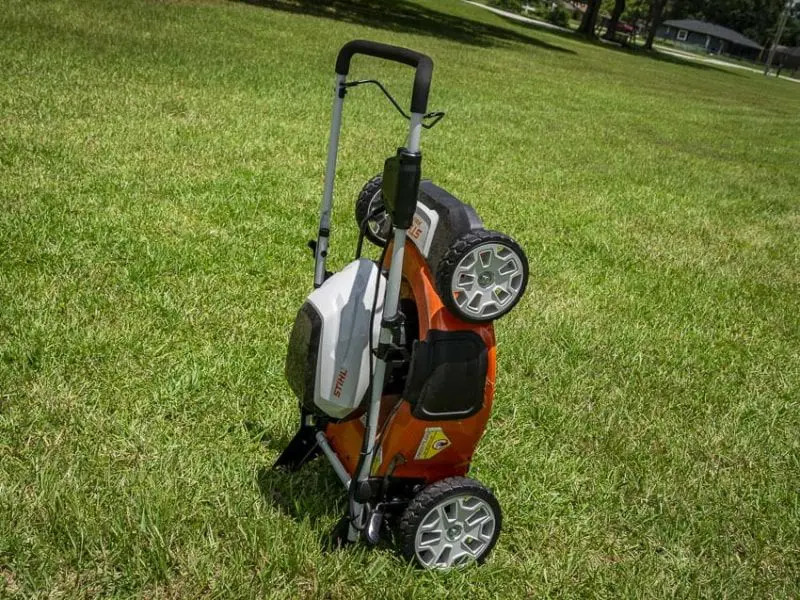
Additional Features
- Discharge options available: mulch, bag, and side discharge
- Additional battery bay for storage
- Battery recharge in about an hour

Value
The Stihl RMA 510 can be picked up as a kit or as a bare tool. Kitted with the AP 300 battery and a charger, you’re looking at a price tag of $549 ($749 for the self-propelled RMA 510 V). As a bare tool, the base mower runs just $299. In either case, your Stihl mower comes with a 3-year warranty and support from your local Stihl dealer network.
Stihl definitely isn’t new to the battery-powered game, and so there are quite a few tools available for use with the 36V AP300 battery platform. The lineup includes this mower, plus chainsaws, string trimmers, blowers, hedge trimmers, pole saws, and the KMA 130 R KombiSystem.
The Bottom Line
The Stihl RMA 510 didn’t overrun any one category in particular, but it performed very well in almost area we tested. It’s light, it has a full feature set (minus, well, you know, the self-propelling bit…but that’s coming), and it has a whole lot of power.
In the end, the Stihl finished second overall, losing out to the Makita model. However, while the Makita excels in runtime and decibel level, the Stihl might be the better choice if you need a mower that really ramps up when it gets into the rough stuff.
Stihl Battery-Powered Push Mower Manufacturer Specs
- Model Number: RMA 510 (RMA 510 V for self-propelled)
- Weight: 65.8 lbs (with AP 300 battery)
- Area Mowed: Up to 5,100 sq. ft.
- Cutting Height: 1-3/8″ — 3-3/4″
- Deck Width: 21″
- Cutting Width: 20″
- Grass Catcher Capacity: 19.8 gal
- Watts: 1,100 W
- Battery: 36V AP Series
- Warranty: 3-year limited warranty
- MSRP: $549.99 kit with one AP 300S battery and charger, $299.99 for the bare tool

